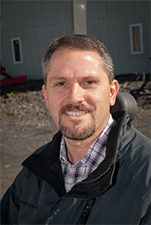We’ve all heard that if you pay attention to the little things the big things will take care of themselves. Jeff Randall is an example of this adage at work. Handling service parts for over 25 different product lines, managing service parts inventories based on location and seasonality, managing people, service parts returns, warranty issues and dealing with customers is the short list of what Randall does each day.
He says inventory organization and management are the biggest keys to being a successful parts manager. In a perfect world, the part arrives one day before the customer needs it. Planning when to place the order, when to have it arrive and doing it, anywhere from 3 months to as much as 12 months ahead of time, is a huge challenge and something Randall juggles on a daily basis.
Having been in the farm equipment business for over 20 years, Randall started as a shipping and receiving clerk before moving to the parts counter. His first managerial experience was when the parts manager at his previous employer asked him to do a few tasks because he had to leave for an eye doctor’s appointment. As it turned out, the parts manager had a torn retina that kept him off work for a full year.
Randall learned a lot working for Green Mountain Tractor, which was later purchased by CVE. When he ran into his first big issue as parts manager at Green Mountain he asked the owner what he should do. “He just looked at me and said, ‘If I make that decision, I don’t need you,’” Randall says.
|
Jeff Randall Years with Organization: 13 — with CVE and 20 years in the industry. Role: Parts manager at the Middlebury store. “Basically I run the parts department and that consists of managing the employees and managing the business itself as far as having parts when we need them. It’s fun most of the time. If you get everything done right on the foundation, then everything seems to fall in place.” |
This set the tone for how he manages his counter people today.
Organizing for Efficiency
Although CVE has 3 major product lines — Case IH, New Holland and Kubota — they handle 25-30 other product lines and all of their related service parts. In some cases, one part may be used on multiple product lines, but listed under the different part numbers used by each individual OEM. Randall points to O-rings as an example. The same O-ring that is used on a chipper is often used on other equipment.
To simplify things, his parts department created a bin system to sort O-rings by size, which makes it much easier to find them, Randall explains.
“We spend a lot of time organizing so we can find parts quickly. Working at the counter you need to get the customer what he wants and get him out the door so you can answer the phone and get on to the next job,” Randall says.
Mentoring Through the Changes
Having gone through the acquisitions and growth experienced at CVE, Randall says, “The biggest thing for the employees when they get a new owner is they don’t know what is expected of them.”
He has performed the important job of mentoring the parts people in this situation. When CVE acquired the Berlin location in 2012, Randall spent a few weeks at the store working with the parts manager to help get him acclimated. “I’ve been kind of the go-to guy in helping those guys do the everyday stuff because I’ve had the experience,” he says.
Instead of telling someone how to do something, Randall prefers to let them know how he performs the task. “All I’m going to do is tell you how I do it, and you can take that for what it is because you’ve got to do it the way that works best for you. What works for me may not work for you,” he says.
Providing Tools to Succeed
Job performance can be a challenging metric to tackle in the parts department. Randall manages his three parts counter people and the shipping and receiving clerk and prefers a simple approach to measuring their performance. “For me, it’s by observing them — how customers react to them. Or I get phone calls about something that went wrong and then I need to show them what should’ve been done in certain situations,” he says.
However, he does have some concrete means to measure how his employees are doing. In addition to observing their interactions, Randall reviews a daily parts report generated by CVE’s business management software. The report allows him to check on each employee’s sales percentages and determine if there are any problems that need to be addressed.
“We try to give them the tools and show them how to do it without doing it for them,” he says.
Putting the focus on the result and not necessarily detailing the steps of performing the task allows freedom for employees to find their own way and to explore ways to improve processes, Randall explains.
“They do it differently than I do, so I look at the outcome instead of exactly how it happened.” What it comes down to, he says is, “You have to care. You have to care about the customer and the business. If you do, the rest falls into place,” he says.







